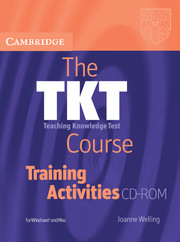1.1 - Homophone bingo
Published online by Cambridge University Press: 09 February 2024
Summary
Instructions
1. Dictate the following words won, too and for. Do not spell the words or confirm the meanings. Ask one trainee to write what they have written on the board, then write won, too and for next to them. Ask trainees to compare the answers with their own. It is very likely that some people will have written one, two and four. Explain/elicit that the words are homophones (words that sound the same but have different meanings and may be spelled differently).
2. Hand out one bingo game board to each trainee. Explain this game of bingo:
• Each bingo game board has five squares with a different part of speech on it.
• To win, a trainee must cover all five squares on their board with counters.
• When the trainer calls out a word which is an example of a part of speech on a trainee's board, the trainee should call out the name of that part of speech.
• The trainee must then prove that the word is an example of that part of speech by giving both:
1. an example sentence / a context / a mime, and
2. the spelling in that part of speech.
• If the trainer is satisfied with the answer, a counter is given to the trainee to cover the part of speech on their board.
• If another trainee thinks the word is also an example of a different part of speech which is on their board, they may also call out, and attempt to win a counter.
• When a trainee has covered all five squares, they shout ‘Bingo!’
NB Trainees may continue suggesting different parts of speech for each word given. If there are no more suggestions from the trainees, the trainer may choose to prompt, asking e.g. How else can you spell …? or by giving an example clue, e.g. Did you get a yes or a no? (to elicit the fact that no is also a noun) or choose to move on to the next word clue.
- Type
- Chapter
- Information
- The TKT Course Training Activities , pp. 9 - 13Publisher: Cambridge University PressFirst published in: 2024

